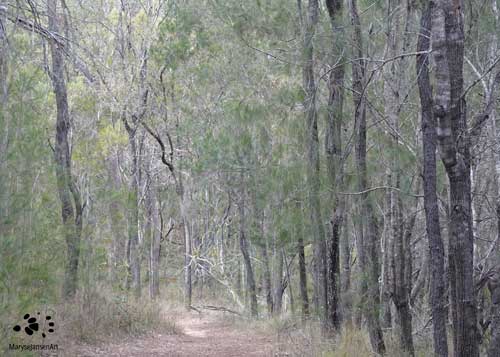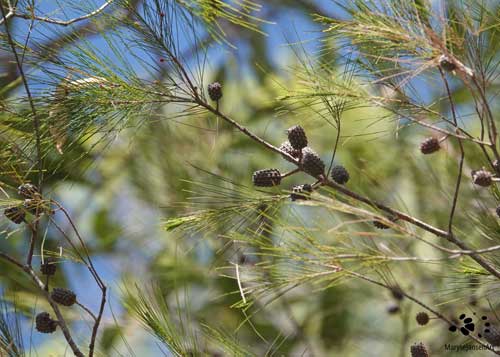Nature Photography with marysejansenart
A Pivotal Species in the Ecosystem

Table of Contents
A walk in a She-Oak Forest
As I am walking through this forest, I notice that the area of the forest closest to the water is dominated by beautiful trees that look a bit like they might be Pine Trees. But what looks like needles are in fact branchlets with leaves that are reduced to small scales. When I examine them close up, I can see the small pale triangles at the joints which are the leaves. They are only a couple of millimeters in size and six to eight of them are arranged on each 20cm long branchlet.
This is not a Pine Tree, it’s a She-oak! She-oaks resemble Pine Trees in more then one way. They drop their ‘needles’ on the ground to form a soft carpet in a similar way. And they also produce what looks like tiny pine cones which carry their seeds.
I love how the needle-like foliage creates a soft look and adds an almost painterly look to the featured image! The soft whistling sound that happens when the breeze rustles gently through the trees makes taking a walk here a special experience. Can you imagine it when you look at the photo?
The Black She-Oak
In Australia there are 61 species of She-oak in the genus Allocasuarina and 6 species in the genus Casuarina, recognized as of April 2023 by ‘Plants of the World Online’ (POWO).
The species I am looking at here is the Black She-oak. The name refers to the very dark colour of the rough, textured bark of the tree. The scientific name is Allocasuarina littoralis. Allocasuarinas were split off the more well known genus of Casuarinas in 1982 by taxonomists. The name Casuarina refers to a bird named Cassowary because the foliage resembles the appearance of the feathers of this large, flightless bird. ‘Allo’ simply means ‘other’.
‘Littoralis’ means of, or belonging to, the sea shore. The distribution of the Black She-oak is indeed covering coastal areas but also extends to inland areas of Queensland, New South Wales, Australian Capital Territory, Victoria and Tasmania.
The She-Oak is an amazingly hardy tree that can tolerate many circumstances: salt coastal winds, flooding, frost, drought and even fires! It prefers a habitat of open forests, on well-drained soils.

An important tree for the ecosystem
She-oaks attract a lot of wildlife! The trees are currently bearing a lot of cones and this attracts Red-browed Finches which like to feed on the seeds. I enjoy watching these pretty little birds fluttering around in the stand of She-oaks, occasionally perching next to a cone to pull out the seeds and devour them. She-oak seeds are a food source for a number of other birds, including the endangered Glossy Black Cockatoo for which it is a critical food source!
She-oaks are also popular nesting trees for birds like Butcherbirds, Willy Wagtails and Peewees (Magpie Lark). The trees attract a lot of insects. Fantails and other small bird species feed on these. I can see a pair of Grey Fantails doing just that! (Find images of these birds in my galleries if you’d like to know what they look like!). A Silver Orb Spider has woven her web between the branches of a She-oak to also take advantage of the presence of insects here. Bees will collect the pollen when the She-oaks are flowering and small mammals, such as the nocturnal Bandicoots, like to dig up the nodules that form on the roots.
These nodules are interesting as they house nitrogen-fixing bacteria! Nitrogen is an important nutrient for all living organisms. While it is abundant as a gas in the atmosphere, it is inaccessible to most organisms in this form. Nitrogen-fixing bacteria convert gaseous nitrogen from the air to nitrate which acts as fertilizer. The She-oaks thus play an important role in the nitrogen-cycle by housing these bacteria.
Furthermore, these trees play a role in preventing erosion and the carpet of ‘needles’ on the ground prevents weed growth.
A useful tree
Aboriginal Peoples have also found various interesting ways to utilize the She-Oak. I remember an Aboriginal guide once told me that they would chew on the young cones while on long walks when they got thirsty and there was limited water available. It would stimulate the saliva production and therefore decrease the urgent need to drink. Apparently chewing on the ‘needles’ has a similar effect. Some tribes have used extracts from bark or wood from certain species for medicinal purposes.
!! WARNING: I don’t know to which particular species these uses may apply – don’t try this yourself unless you are absolutely sure of what you are doing! Read an extended explanation and warning about bush tucker here.
The wood of the She-Oak is hard and therefore often used to make spears, boomerangs, clubs, clapping sticks and more.
Join me on my walk through the She-Oak forest and get a feel for the atmosphere of this amazing ecosystem in the latest episode of ‘Come for a walk in the Australian Bush’.
If you are interested in purchasing a print of ‘Take a Walk in the She-Oak Forest’ or would like to see what the image looks like on the various merchandise products, please head to my shop. If you prefer ‘Black She-Oak’, click shop here.


